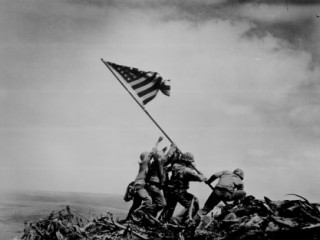
Joseph J. Rosenthal biography
Date of birth : 1911-10-09
Date of death : 2006-08-20
Birthplace : Washington, D.C., U.S.
Nationality : American
Category : Arts and Entertainment
Last modified : 2011-09-14
Credited as : photographer, Raising Flag on Iwa Jima, Pulitzer prize
0 votes so far
Rosenthal was born in 1911 in Washington, D.C., to Russian immigrants. He moved to San Francisco after graduating from high school with the intent to work his way through college. The Depression was still going on, so work was hard to come by. He found a job working with the Newspaper Enterprise Association. After a couple of years there, he became a reporter and photographer for the San Francisco News . He later worked for the New York Times-Wide World Photos as chief photographer and manager. The company was bought by AP.
The United States soon joined the fight in World War II and like many young men, Rosenthal wanted to do his part. He tried to enlist in both the Army and Navy but was rejected because of poor eyesight. Undeterred he joined the U.S. Maritime Service as a photographer. He spent his time photographing convoys in the Atlantic Ocean in such areas as North Africa and Britain.
After a year of service, Rosenthal returned to AP. He was assigned to the Pacific campaign. He had taken photos of the fighting in Guam and Peleliu before finding himself on the island of Iwo Jima. In order to attack Tokyo and other areas of Japan, the U.S. armed services needed a base on Iwo Jima. When the first wave of soldiers began the assault on the island, they were met with 21,000 Japanese soldiers. The battle had waged for two days in February of 1945, when the Marines overtook a hill. The commander decided to raise a flag. Four marines raised a small U.S flag to commemorate the victory. This flag raising was captured on film by Louis Lowery of Leatherneck magazine.
On his way down from taking the photo, Lowery ran into Rosenthal and a couple of other photographers and told them about the flag raising. The group immediately went up the hill to the flag. At the same time, a commander ordered the small flag taken down and a much larger flag that could be seen below and out at sea, erected in its place. The group of photographers, including Rosenthal, arrived in time to capture this.
Rosenthal, a short man, wanted to get a picture of both flags, but needed to move to another location. He still could not get the shot and had to stand on rocks and a sand bag. As the new flag was being raised, he turned and was able to take the picture as five Marines and a Navy corpsman raised the second flag. Afterward, he asked the men to face the camera to take a second picture, which he called his gung-ho picture.
Rosenthal sent the roll of film to Guam for processing. As the battle for Iwo Jima continued, Rosenthal's picture raced across the United States. The image of the flag raising came during a time when many U.S. citizens were weary of the fighting. According to the London Times , "The uncannily expressive perfection of the photograph's compositionthe small team of soldiers straining heroically to raise the Stars and Stripes amid the shell-blasted wreckage of the Japanese hilltop redoubtwas not lost on all those who saw it " The image became a symbol of courage and unity to the United States. It energized the nation. However, on Iwo Jima, half of the flag raisers had lost their lives. In all, more than 6,000 soldiers died on Iwo Jima. The remaining three flag raisers were sent home.
As his photo grew in popularity, many congratulated Rosenthal. Some began to question whether the photo had been staged and when Rosenthal was asked, he said sure because he was unsure of which photograph was so widely acclaimed, but assumed it was his gung-ho picture. His affirmation sparked a controversy that took years to resolve. When film footage was found that corroborated his image, Rosenthal was vindicated.
The photograph was used on posters to help publicize a war-bond campaign. The surviving flag raisers were used to promote that effort as well. Later, the photograph became a three-cent stamp that commemorated the U.S. Marine Corps. It broke first-day sale records around the country.
After the war, Rosenthal returned to San Francisco and worked for the San Francisco Chronicle until he retired in 1981. In 1945 Rosenthal was awarded the Pulitzer Prize for his "Flag Raising on Iwo Jima" photograph. Many wanted to learn all about him but he told Collier 's magazine, quoted in the Los Angeles Times , "What difference does it make who took the picture? I took it, but the Marines took Iwo Jima."
The photograph was used time and time again throughout the years. A sculpture recreating the image was erected and can be found in the Arlington National Cemetery, as a memorial to fallen U.S. Marines.
Most recently, photographer Thomas E. Franklin took a similar picture of three firefighters raising a flag at the World Trade Center, after the September 11, 2001, attacks in New York City.
Rosenthal spent his later years as a historian for all who wanted information about the flag raising on Iwo Jima. He died on August 20, 2006, in Novato, California, at the age of 94. He is survived by his daughter, Anne; his son, Joseph, Jr., and several grandchildren and great-grandchildren.
















